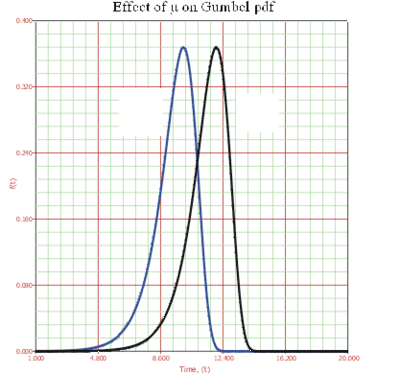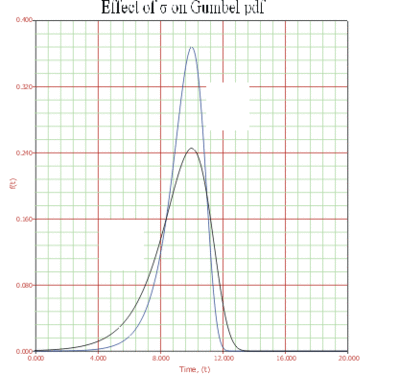Template:Characteristics of the gumbel distribution: Difference between revisions
Jump to navigation
Jump to search
No edit summary |
|||
| Line 2: | Line 2: | ||
Some of the specific characteristics of the Gumbel distribution are the following: | Some of the specific characteristics of the Gumbel distribution are the following: | ||
: | :* The shape of the Gumbel distribution is skewed to the left. The Gumbel <math>pdf</math> has no shape parameter. This means that the Gumbel <math>pdf</math> has only one shape, which does not change. | ||
: | :* The Gumbel <math>pdf</math> has location parameter <math>\mu ,</math> which is equal to the mode <math>\tilde{T},</math> but it differs from median and mean. This is because the Gumbel distribution is not symmetrical about its <math>\mu </math> . | ||
: | :* As <math>\mu </math> decreases, the <math>pdf</math> is shifted to the left. | ||
: | :* As <math>\mu </math> increases, the <math>pdf</math> is shifted to the right. | ||
[[Image:effectofmuongumbel.gif|thumb|center|400px| ]] | [[Image:effectofmuongumbel.gif|thumb|center|400px| ]] | ||
: | :* As <math>\sigma </math> increases, the <math>pdf</math> spreads out and becomes shallower. | ||
: | :* As <math>\sigma </math> decreases, the <math>pdf</math> becomes taller and narrower. | ||
: | :* For <math>T=\pm \infty ,</math> <math>pdf=0.</math> For <math>T=\mu </math> , the <math>pdf</math> reaches its maximum point <math>\frac{1}{\sigma e}</math> | ||
[[Image:effectofsigmaongumbel.gif|thumb|center|400px| ]] | [[Image:effectofsigmaongumbel.gif|thumb|center|400px| ]] | ||
: | :* The points of inflection of the <math>pdf</math> graph are <math>T=\mu \pm \sigma \ln (\tfrac{3\pm \sqrt{5}}{2})</math> or <math>T\approx \mu \pm \sigma 0.96242</math> . | ||
: | :* If times follow the Weibull distribution, then the logarithm of times follow a Gumbel distribution. If <math>{{t}_{i}}</math> follows a Weibull distribution with <math>\beta </math> and <math>\eta </math> , then the <math>Ln({{t}_{i}})</math> follows a Gumbel distribution with <math>\mu =\ln (\eta )</math> and <math>\sigma =\tfrac{1}{\beta }</math> [32] <math>.</math> | ||
Revision as of 18:31, 20 February 2012
Characteristics of the Gumbel Distribution
Some of the specific characteristics of the Gumbel distribution are the following:
- The shape of the Gumbel distribution is skewed to the left. The Gumbel [math]\displaystyle{ pdf }[/math] has no shape parameter. This means that the Gumbel [math]\displaystyle{ pdf }[/math] has only one shape, which does not change.
- The Gumbel [math]\displaystyle{ pdf }[/math] has location parameter [math]\displaystyle{ \mu , }[/math] which is equal to the mode [math]\displaystyle{ \tilde{T}, }[/math] but it differs from median and mean. This is because the Gumbel distribution is not symmetrical about its [math]\displaystyle{ \mu }[/math] .
- As [math]\displaystyle{ \mu }[/math] decreases, the [math]\displaystyle{ pdf }[/math] is shifted to the left.
- As [math]\displaystyle{ \mu }[/math] increases, the [math]\displaystyle{ pdf }[/math] is shifted to the right.
- As [math]\displaystyle{ \sigma }[/math] increases, the [math]\displaystyle{ pdf }[/math] spreads out and becomes shallower.
- As [math]\displaystyle{ \sigma }[/math] decreases, the [math]\displaystyle{ pdf }[/math] becomes taller and narrower.
- For [math]\displaystyle{ T=\pm \infty , }[/math] [math]\displaystyle{ pdf=0. }[/math] For [math]\displaystyle{ T=\mu }[/math] , the [math]\displaystyle{ pdf }[/math] reaches its maximum point [math]\displaystyle{ \frac{1}{\sigma e} }[/math]
- The points of inflection of the [math]\displaystyle{ pdf }[/math] graph are [math]\displaystyle{ T=\mu \pm \sigma \ln (\tfrac{3\pm \sqrt{5}}{2}) }[/math] or [math]\displaystyle{ T\approx \mu \pm \sigma 0.96242 }[/math] .
- If times follow the Weibull distribution, then the logarithm of times follow a Gumbel distribution. If [math]\displaystyle{ {{t}_{i}} }[/math] follows a Weibull distribution with [math]\displaystyle{ \beta }[/math] and [math]\displaystyle{ \eta }[/math] , then the [math]\displaystyle{ Ln({{t}_{i}}) }[/math] follows a Gumbel distribution with [math]\displaystyle{ \mu =\ln (\eta ) }[/math] and [math]\displaystyle{ \sigma =\tfrac{1}{\beta } }[/math] [32] [math]\displaystyle{ . }[/math]

